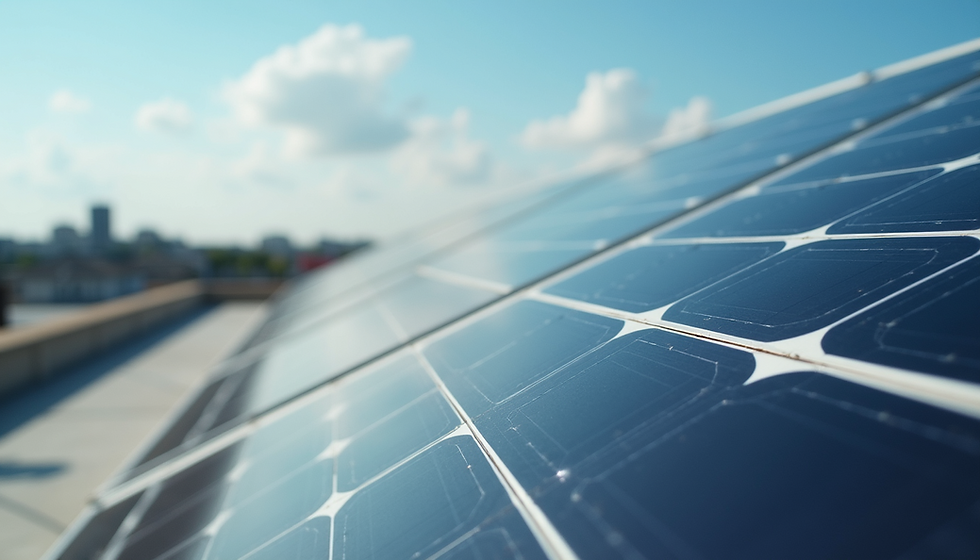The Role of Artificial Intelligence in Sustainable Energy
- Sankalp Agrawal

- May 16
- 3 min read
As the world grapples with the twin challenges of energy demand and climate change, artificial intelligence (AI) is emerging as a transformative force in the transition to sustainable energy. From optimizing renewable energy production to enhancing grid efficiency and reducing consumption, AI is playing a pivotal role in reshaping the global energy landscape. In this blog, we’ll explore the many ways AI is revolutionizing sustainable energy systems and accelerating the path to a greener future.

Understanding the Link Between AI and Sustainable Energy
AI involves the use of algorithms and data analysis to simulate human intelligence in machines. In the context of sustainable energy, AI leverages big data from sensors, weather forecasts, consumption patterns, and equipment to automate decision-making and system optimization. This technological synergy allows for smarter and more efficient use of renewable resources such as solar, wind, and hydropower.
Unlike traditional energy systems, where forecasting and decision-making often depend on human estimates, AI can process vast amounts of real-time data and respond instantly. This shift enables predictive maintenance, better energy distribution, reduced waste, and increased integration of intermittent energy sources into the grid.
Optimizing Renewable Energy Generation
AI has the potential to maximize the efficiency and reliability of renewable energy sources. In solar and wind farms, AI algorithms analyze weather conditions, sunlight intensity, wind speed, and historical production data to forecast energy output with high accuracy.
For instance, Google DeepMind’s AI has been used to increase wind energy value by predicting wind power output 36 hours in advance. This foresight allows grid operators to schedule energy use more effectively, improving the reliability of wind power.
In solar power, AI systems monitor panel performance and environmental factors to adjust panel angles and identify shading or malfunctioning cells, maximizing output.
Smarter Energy Grids
AI is transforming traditional energy grids into intelligent, self-regulating systems. Smart grids use AI to balance electricity supply and demand, reducing blackouts and ensuring a stable power supply.
With real-time monitoring, AI systems can detect anomalies, forecast load demands, and automate responses to changing energy needs. For example, during peak hours, AI can automatically switch energy consumption to off-peak times or pull stored energy from batteries, minimizing stress on the grid.
Microgrids—localized energy systems powered by renewables—also benefit from AI. These systems can operate independently or connect to the main grid. AI enables microgrids to manage resources efficiently, detect faults, and optimize distribution without human intervention.

Improving Energy Efficiency in Buildings and Cities
Buildings account for nearly 40% of global energy consumption. AI-driven solutions in smart buildings are helping reduce this footprint through automation and energy management systems. AI can learn occupant behavior, adjust heating and cooling systems in real-time, control lighting based on occupancy, and optimize appliance usage.
In cities, AI supports smart infrastructure—such as adaptive traffic lights, electric vehicle (EV) charging station placement, and public transit optimization—that collectively lowers energy consumption and emissions. AI can also coordinate demand response programs, where consumers are incentivized to reduce energy use during peak times.
Predictive Maintenance and Operational Efficiency
Energy infrastructure maintenance is costly and time-consuming. AI helps utilities shift from reactive to predictive maintenance models. By analyzing sensor data, AI can forecast equipment failures before they happen, allowing timely interventions that reduce downtime and repair costs.
This is particularly valuable in wind turbines, solar panels, and battery storage systems, where operational reliability is critical. Predictive maintenance not only extends the lifespan of assets but also improves the return on investment in renewable technologies.
AI in Policy and Investment Decision-Making
AI tools are also being used to guide policy and investment decisions in sustainable energy. Governments and businesses use AI to model different energy scenarios, estimate carbon footprints, and assess the impact of new technologies or regulations.
AI-powered analytics platforms can identify the most effective areas for deploying renewable infrastructure, reducing risk and ensuring maximum impact from public and private investments.
Challenges and Ethical Considerations
While the benefits of AI in sustainable energy are immense, there are challenges. High-quality data is essential for effective AI, and many regions still lack the infrastructure for real-time data collection. Additionally, the energy consumption of data centers that power AI must also be managed sustainably.
Ethical concerns such as data privacy, job displacement, and algorithmic bias also need to be addressed. It’s crucial that the deployment of AI in energy respects transparency, fairness, and environmental justice.
A Smarter, Greener Future with Artificial Intelligence in Sustainable Energy
Artificial intelligence is rapidly transforming how we produce, manage, and consume energy. By enhancing the efficiency, reliability, and integration of renewable energy sources, AI is a cornerstone technology in the fight against climate change.
As we continue to innovate, the fusion of AI and sustainable energy holds the promise of a smarter, cleaner, and more resilient energy future. Embracing this synergy will be key to meeting global sustainability goals and creating a healthier planet for generations to come.






Comments